Building the Ideal Restaurant Tech Stack: Tools Every Modern Restaurant Needs
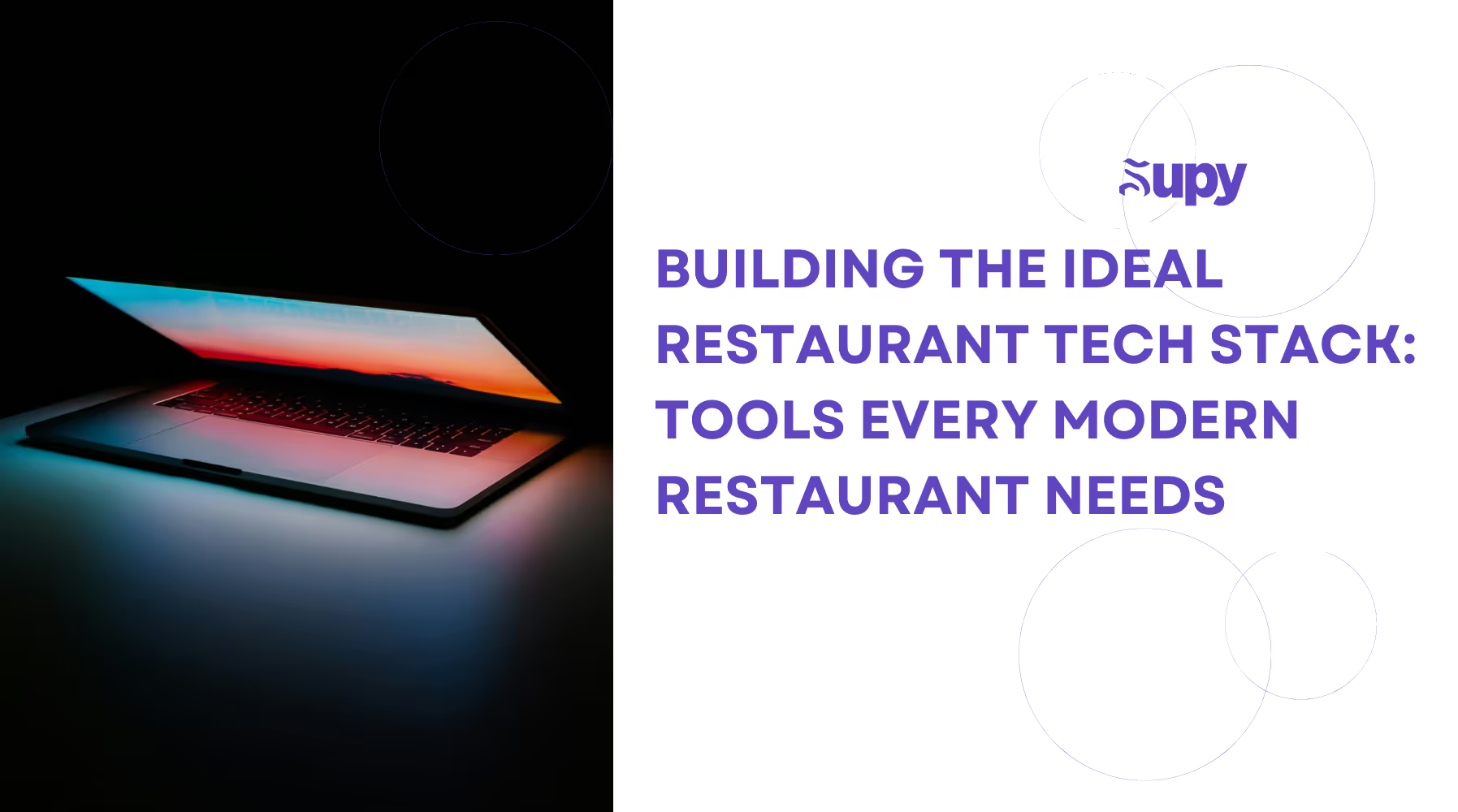
You may already know about the infrastructural needs of any modern restaurant: food storage containers, cooking equipment, and other commercial kitchen equipment for food preparation, but what about your restaurant's tech stack?
In the modern restaurant industry, many businesses are starting to find it impossible to run a multi-location venture without a strong foundational tech stack to handle all of their administrative needs. The integration of these advanced tools has allowed many businesses to check and manage their costs and operations as they scale their business up to ever-increasing heights. Without the right technological support, restaurants often face several issues, such as inventory mismanagement, slow order processing, and financial discrepancies, all of which can impede growth and customer satisfaction.
- POS Systems as the Foundation of a Strong Tech Stack
- Smart Solutions for Inventory Management and Optimization
- Automating Your Procurement Processes
- Increase Your Restaurant’s Profitability with Accounting Software
- Using Integrated Restaurant Tech to Improve Restaurant Decision-Making
- Scaling and Future-Proofing Your Business with Cloud-Based Solutions
- The Common Pitfalls of Building a Restaurant Tech Stack
- Conclusion
- About Supy
Typically, the latest restaurant technology trends from the National Restaurant Association have declared that a robust tech stack is made up of the following three items:
- Point of Sale (POS) systems,
- Inventory management software, and
- Accounting tools
At Supy, we offer a comprehensive suite of tools that integrate these technologies to create a single, unified, data-driven environment. Read on to learn about Supy’s tech stack and how it’s been designed to help restaurateurs like you!
1. POS Systems as the Foundation of a Strong Tech Stack

A restaurant point of sale (POS) system is a combination of software and hardware that manages a restaurant’s sales transactions, processes payments, and tracks inventory. Beyond these basic functions, a modern point-of-sale system can also integrate with other operational components, such as your kitchen display system, making it an indispensable part of efficient restaurant management. The best restaurant POS systems keep track of ingredients in real-time, helping restaurants avoid overstocking or running out of essential items.
Ideally, your POS system should have the following features:
- Real-time Order Tracking: This feature ensures that orders are promptly communicated to the kitchen, reducing preparation times and minimizing errors. Whether your order has been drafted, submitted, confirmed, denied, or closed, Supy lets you and your team stay on top of things with its order status checker.
- Mobile Compatibility: Mobile POS systems allow staff to take orders and process payments tableside, enhancing efficiency and providing a more personalized dining experience. With Supy’s interactive and mobile-friendly restaurant dashboards, it’s a breeze to check out your procurement, inventory, and sales stats at a single glance!
- Cloud-based Access: Cloud integration allows managers to monitor sales, inventory, and other vital metrics remotely. With all your relevant data backed up on the cloud, restaurant owners and managers can proactively manage their food waste, optimize their restaurant operations, and expand their sales channels with confidence.
It’s also important to have a POS system that integrates with common inventory management and accounting software. Such integration ensures that sales data automatically updates inventory levels and financial records, reducing manual data entry and the risk of errors. At Supy, our solutions facilitate the automatic synchronization of sales data with platforms like Xero, MYOB AccountRight, and Microsoft Dynamics Navision to provide a unified view of your restaurant's performance. You can check out the full list of integrations here.
2. Smart Solutions for Inventory Management and Optimization
Unsurprisingly, the next challenge many restaurants face is figuring out how to effectively manage their inventory. Investing in this kind of management is crucial for restaurants that are trying to minimize their waste, control food costs, and prevent shortages.
The key features of Supy’s inventory management tool include:
- Automated Stock Tracking: This feature accelerates the stock counting process by running synchronized cross-device counting sessions with your team. Supy makes it even easier to keep track of the variance between your actual and theoretical stock by making these features available with one single click on the app!
- Supplier Integration: Coordinating with your suppliers through the latest restaurant technology is an excellent way to streamline your supply chain and prevent overstocking. This ensures sustainable practices like avoiding spoilage and excess inventory that can lead to wastage.
- Demand Forecasting: Supy’s forecasting tools are designed to use historical data to predict future needs, helping you plan your operations better and order ingredients more accurately. By analyzing past sales and consumption patterns, these tools can estimate how much of each ingredient will be required for a given period. This foresight allows you to adjust orders pre-emptively, reducing the likelihood of surplus stock that could become waste.
Case Study
Many restaurants have already experienced the transformative effects of Supy’s restaurant management software. With 13 branches across the country, Pinza! was experiencing large variance and profit losses due to an inconsistent recording of events. Supy’s solution was to bring them a full onboarding with data centralization and implementation of accurate recipes, items, suppliers, and first stock count for all kitchens.
“Implementing controls in our operation with Supy’s Back of House allowed us to have clear visibility on our cost,” says Tamer Elkhayat, managing partner at Pinza! With Supy’s help, this business managed to reduce its variance by a whopping 85%! All thanks to easy, regular updates of stock, wastage, and invoices with Supy’s mobile app.
3. Smart Solutions for Inventory Management and Optimization
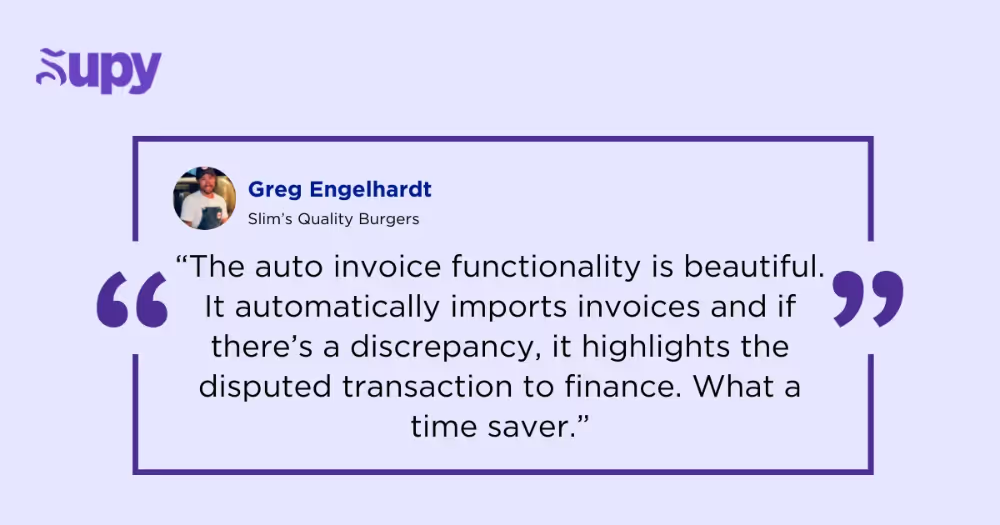
Unsurprisingly, the next challenge many restaurants face is figuring out how to effectively manage their inventory. Investing in this kind of management is crucial for restaurants that are trying to minimize their waste, control food costs, and prevent shortages.
The key features of Supy’s inventory management tool include:
- Automated Stock Tracking: This feature accelerates the stock counting process by running synchronized cross-device counting sessions with your team. Supy makes it even easier to keep track of the variance between your actual and theoretical stock by making these features available with one single click on the app!
- Supplier Integration: Coordinating with your suppliers through the latest restaurant technology is an excellent way to streamline your supply chain and prevent overstocking. This ensures sustainable practices like avoiding spoilage and excess inventory that can lead to wastage.
- Demand Forecasting: Supy’s forecasting tools are designed to use historical data to predict future needs, helping you plan your operations better and order ingredients more accurately. By analyzing past sales and consumption patterns, these tools can estimate how much of each ingredient will be required for a given period. This foresight allows you to adjust orders pre-emptively, reducing the likelihood of surplus stock that could become waste.
Case Study
Many restaurants have already experienced the transformative effects of Supy’s restaurant management software. With 13 branches across the country, Pinza! was experiencing large variance and profit losses due to an inconsistent recording of events. Supy’s solution was to bring them a full onboarding with data centralization and implementation of accurate recipes, items, suppliers, and first stock count for all kitchens.
“Implementing controls in our operation with Supy’s Back of House allowed us to have clear visibility on our cost,” says Tamer Elkhayat, managing partner at Pinza! With Supy’s help, this business managed to reduce its variance by a whopping 85%! All thanks to easy, regular updates of stock, wastage, and invoices with Supy’s mobile app.
3. Automating Your Procurement Processes
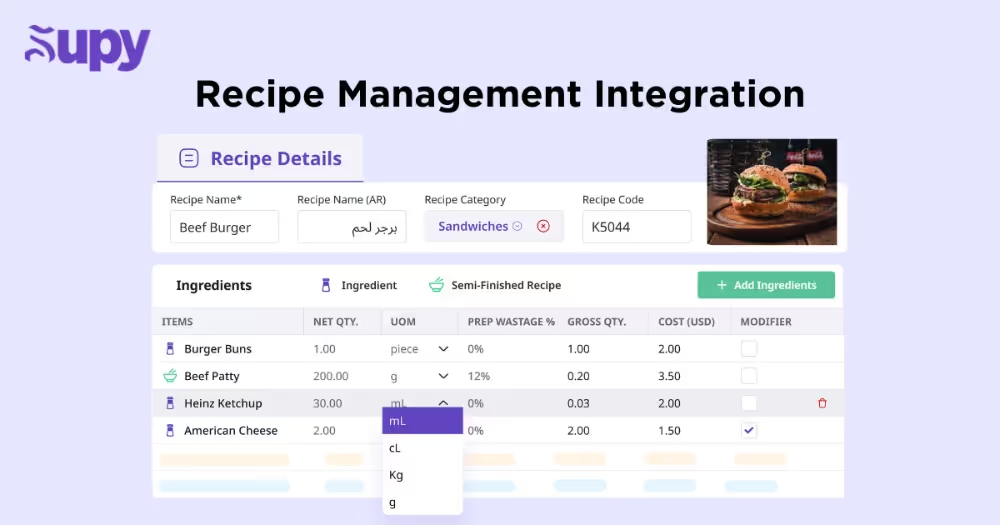
It has often been seen that manual restaurant procurement processes can lead restaurant managers into issues like stock mismatches and supplier miscommunications. Automating your procurement processes can thus lead to several benefits:
- Centralized Supplier Management: A unified platform consolidates supplier information, streamlining communication and order placement.
- Real-Time Cost Tracking: Automation provides up-to-date insights into expenses, aiding in budget management and cost control.
- Order Accuracy: Automated systems reduce human errors, ensuring precise orders and timely deliveries.
Here’s why Supy's procurement solutions might be right for you:
- Streamlining Supplier Communication: Supy centralizes interactions between you and your suppliers. By coordinating with your suppliers through Supy, you can streamline your supply chain and prevent overstocking. This ensures sustainable practices like avoiding spoilage and excess inventory that can lead to wastage.
- Create Categorized Purchase Orders: Take the hassle out of ordering ingredients for your team by collecting items sourced by different suppliers under their categories. If you find yourself regularly sourcing items from the same supplier, Supy will even let you set them as a preferred supplier to accelerate the purchasing process.
Identify Your Top Suppliers and Build Business Relationships: One underestimated but vital part of building a business is developing relationships! Supy makes it easy to track how each of your suppliers treats you. Is one giving you a higher discount than another? Now you can check to see which suppliers are increasing their prices or throwing you a freebie from time to time to find the best supplier worth your money!
4. Increase Your Restaurant’s Profitability with Accounting Software
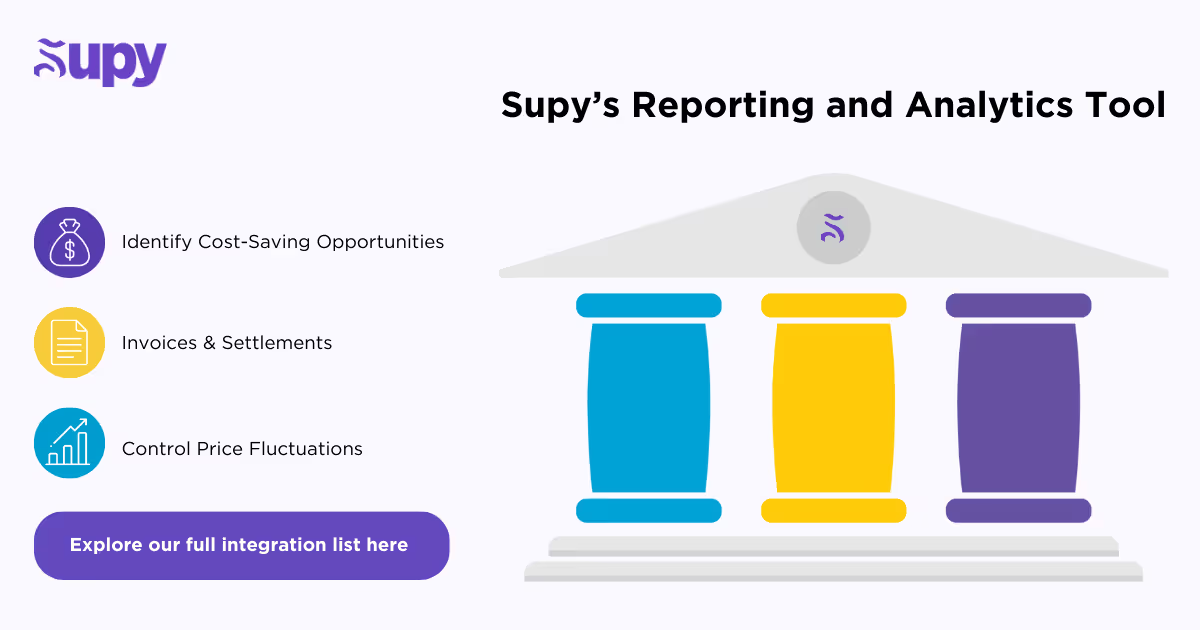
As Geordy Murphy, President of Cypress Hospitality Group, notes, "The restaurant business is a business of pay, and there are a ton of pennies that you have to keep an eye on." In an article by PRWeb, Geordie claims that collecting real-time data can boost a restaurant’s profits by up to 40%!
Effective accounting software is a crucial part of this process. By providing real-time financial tracking, these software are designed to help you manage your cash flow while simultaneously conducting several profitability analyses.
Some key features of Supy’s Reporting and Analytics tool include:
- Identifying Cost-Saving Opportunities: One of the most exciting features to come out of the Supy app is its potential to find cost-saving opportunities for you and your business. Use the analytics feature to discover which of your suppliers leads to the most savings, gain deep-dive insights into your purchasing patterns, and oversee supplier performance.
- Invoices & Settlements: Often considered one of the trickier aspects of managing a restaurant business, Supy allows restaurant leaders to accelerate their invoice recording processes, boost their inventory accuracy, and manage statements of account to stay in control of their payments at all times.
- Control The Impact Price Fluctuations Have On Your Data: In an era of rising inflation, it’s important for restaurants to know how each change in price affects their menu’s cost analytics. Maximize the accuracy of your reporting for confident decision-making with Supy’s reporting and analytics features!
Supy also integrates with accounting platforms like Xero, MYOB AccountRight, and Microsoft Dynamics Nivision to provide a unified view of your restaurant's performance. Click here for a full list of our integrations.
5. Using Integrated Restaurant Tech to Improve Restaurant Decision Making
By integrating all three of these core restaurant technologies—Point of Sale (POS) systems, inventory management, and accounting software—restaurant owners and managers are paving the way toward a more cohesive, data-driven system of operations. This unification offers several advantages:
- Centralized Reporting: Consolidating data from various sources provides a comprehensive view of operations, enabling informed decision-making. For instance, integrating POS with inventory management allows real-time tracking of ingredient usage, ensuring stock levels are optimized to meet demand.
- Reduced Manual Work: By automating your processes, you can minimize your need for manual data entry, thus freeing up your staff to focus on other customer enhancing experiences.
- Improved Forecasting: Access to real-time data enables accurate sales and inventory forecasts. With predictive analytics tools, restaurant managers can analyze their historical data to anticipate future trends, allowing for proactive adjustments in menu offerings and staffing.
Case Study
Burger28, a renowned local burger chain based in the UAE, used to struggle to maintain operational excellence across its multiple locations. It was difficult to reduce variance and monitor key metrics across inventories, while also delivering insights to floor staff for data-driven decision-making. The owner, Alex Debarre, also wanted to grow his business sustainably, maximizing the productivity of employees without distracting them or having to hire more staff.
With Supy’s help, Burger28 has managed to successfully centralize its data, eliminating all paperwork from this small business and aggregating its entire inventory onto a central platform. Owner Alex Debarre is now happy to report a 6% profitability increase, and a hundred hours of manual labor saved every month!
6. Scaling and Future-Proofing Your Business with Cloud-Based Solutions
In today’s restaurant industry, cloud-based solutions have become an indispensable tool for multi-location establishments. Managing multiple restaurant locations presents several unique challenges, including maintaining consistent operations, synchronizing data, and overseeing inventory across each branch location. With cloud-based systems, restaurants have real-time access to data from any of their locations. This centralization ensures uniformity and streamlines operations across all branches.
Benefits of Cloud Technology in Restaurants
- Remote Access: Managers and staff can access vital information and perform essential tasks from anywhere, facilitating efficient oversight and decision-making.
- Automatic System Updates: Cloud-based platforms are designed to receive automatic updates so that their software is always up to date. This ensures that each of your locations is operating with the latest features and security enhancements without having to manually install updates at each location.
- Multi-Location Scalability: Cloud-based systems are designed to help you scale your business easily and effortlessly. This accommodates your restaurant’s need to add new locations without the tedium of significant infrastructure changes.
7. The Common Pitfalls of Building a Restaurant Tech Stack
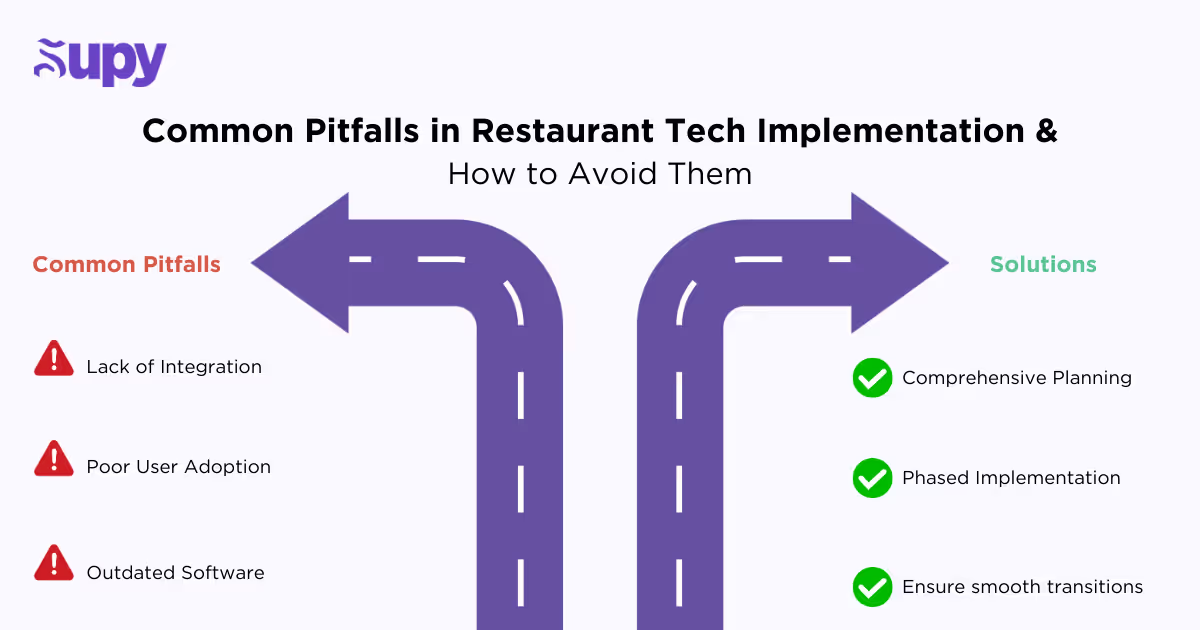
- Although implementing a restaurant tech stack is a great way to enhance your restaurant operations, there are several common pitfalls that might be hindering your success:
- Lack of Integration: Adopting disparate tech ecosystems that don't communicate with each other can lead to the creation of data silos that make operations difficult. Make sure your POS, inventory management, and accounting software are all compatible before installation.
- Poor User Adoption: Introducing new technology to your processes without providing adequate training can result in staff resistance and underutilization. It's essential to provide comprehensive staff training in order to facilitate a smooth system of tech adoption.
- Outdated Software: Relying on obsolete forms of technology can hold you back and compromise the security of your data. By regularly updating your systems and investing in the latest tech solutions, you can make sure you’re operating at optimal levels and always protected against major security vulnerabilities.
- Comprehensive Planning: Define your restaurant's specific needs and objectives before selecting your technology solutions. Involving key stakeholders in the planning process can help you make informed decisions that align with your operational goals.
- Lack of Integration: Adopting disparate tech ecosystems that don't communicate with each other can lead to the creation of data silos that make operations difficult. Make sure your POS, inventory management, and accounting software are all compatible before installation.
8. Conclusion
It is thus evident that in today’s fast-paced and competitive restaurant landscape, adopting the right tech stack is a crucial step towards streamlining your operations and improving customer relationship management. We have seen how POS systems, inventory management software, and accounting tools form the main backbone of any modern restaurant tech stack. When integrated effectively, these technologies provide restaurants with real-time data that allows for smarter decision-making and more efficient operations.
Supy’s comprehensive suite of solutions was designed specifically with these challenges in mind. From seamless inventory management tools that reduce waste to automated procurement methods, Supy is designed to enhance every aspect of restaurant management.
Don’t let outdated systems hold you back. Sign up for our newsletter or book a free demo today to discover how we can help you build a more efficient, data-driven restaurant tech stack and take your business to the next level!
To learn more about restaurant inventory management software, click here.
9. About Supy
Supy is the best restaurant inventory management software platform tailored for multi-branch restaurants and franchises. With features like real-time inventory tracking, smart procurement systems, and advanced analytics, Supy helps restaurants manage their various demands effectively and provides the tools restaurants need to thrive in a dynamic industry.
For the latest expert insights, download Supy’s ebook: The Ultimate Guide to Reducing Food Costs in Multi-Branch & Enterprise Restaurants.
Ready to find out more? Schedule a demo with Supy today and take the first step towards a streamlined, profitable future.
What is a restaurant tech stack? A restaurant tech stack is the combination of software tools and systems that operators use to manage operations — including POS systems, inventory management, online ordering, staff scheduling, accounting, and analytics platforms. Why is it important to build the right restaurant tech stack? The right tech stack streamlines operations, improves efficiency, reduces errors, and helps operators make smarter, data-driven decisions — ultimately boosting profitability. What tools should be part of a modern restaurant tech stack?
A complete tech stack includes:
POS system
Inventory management (like Supy)
Online ordering & delivery integration
Employee scheduling
Accounting and ERP
Reporting and analytics dashboards
How does inventory software fit into a restaurant tech stack?
Inventory software is essential for tracking food costs, managing stock levels, and reducing waste. Tools like Supy give operators real-time visibility and tighter control over COGS across all branches.
Can a restaurant tech stack help reduce food costs?
Yes. Integrated inventory tools, supplier data, and analytics allow operators to make faster, smarter decisions that directly impact food cost and profitability.
Should all tools in my tech stack be integrated?
Absolutely. Seamless integrations between your POS, inventory system, ERP, and reporting tools eliminate manual work, reduce errors, and deliver more accurate insights.
What’s the difference between ERP systems and specialized tools like Supy?
ERP systems offer general back-office functionality. Supy is a specialized inventory and procurement platform built specifically for multi-branch restaurant operations, offering deeper insights and faster ROI.
How does a good tech stack support multi-location restaurants?
It centralizes data, standardizes operations, and enables oversight across locations. Supy, for example, allows restaurant groups to manage procurement, stock, and reporting from one platform.
Is it better to use an all-in-one platform or specialized tools?
It depends on your scale. For larger or growing restaurant groups, specialized tools like Supy deliver more operational depth and accuracy than generalist all-in-one systems.
How do I know if my restaurant tech stack needs an upgrade?
If you’re manually reconciling data, struggling with stock control, or waiting until month-end for key insights, it’s likely time to upgrade to a more connected, real-time solution like Supy.







